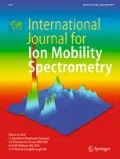Abstract
Theoretical considerations to describe the motion of ion swarms in weak electrical fields in gases at ambient pressure normally start with pulses of Gaussian form to inject ions in the drift region of the ion mobility spectrometer. The influence of the drift gas flowing contrary to the ion drift direction is mostly neglected with respect to the form of the pulse. At the Faraday-plate a superposition of the balance between energy gain between the collisions and loss by collisions with neutral molecules during the drift towards the electrode and influence of the motion of the drift gas molecules flowing contrary becomes visible in peak shape. An analytical description on the basis of Gaussian- and Breit-Wigner-Functions is presented for the single spectrum as well as for 3D-dependences within MCC/IMS with regard to the additional influence of retention time dependencies.








Similar content being viewed by others
References
Baumbach JI, Eiceman GA (1999) Ion mobility spectrometry: arriving on site and moving beyond a low profile. Appl Spectrosc 53:338A–355A
Eiceman GA, Karpas Z (2005) Ion mobility spectrometry, vol 1, edn 1. CRC, Taylor & Francis, Boca Raton
Borsdorf H, Eiceman GA (2006) Ion mobility spectrometry: principles and applications. Appl Spectrosc Rev 41:323–375
Creaser CS et al (2004) Ion mobility spectrometry: a review. Part 1. Structural analysis by mobility measurement. Analyst 129:984–994
Stach J, Baumbach JI (2002) Ion mobility spectrometry—basic elements and applications. Int J Ion Mobility Spectrom 5:1–21
Revercomb HE, Mason EA (1975) Theory of plasma chromatography gaseous electrophoresis—review. Anal Chem 47:970–983
Bradbury NE, Nielsen RA (1936) Absolute values of the electron mobility in hydrogen. Phys Rev 49:388–393
Eiceman GA, Leasure CS, Vandiver VJ, Rico G (1985) Flow characteristics in a segmented closed-tube design for ion-mobility spectrometry. Anal Chim Acta 175:135–145
Karpas Z, Berant Z (1989) Effect of drift gas on mobility of ions. J Phys Chem 93:3021–3025
Asbury GR, Hill HHJ (2000) Using different drift gases to change separation factors (α) in ion mobility spectrometry. Anal Chem 72:580–584
Thomas CLP, Rezgui ND, Kanu AB, Munro WA (2002) Measuring the temperature of the drift gas in an ion mobility spectrometer: a technical note. Int J Ion Mobility Spectrom 5:31–38
Matz LM, Hill HH, Beegle LW, Kanik I (2002) Investigation of drift gas selectivity in high resolution ion mobility spectrometry with mass spectrometry detection. J Am Soc Mass Spectrom 13:300–307
Nazarov EG, Miller RA, Eiceman GA, Krylov E, Tadjikov B (2001) Effect of the electric field strength, drift gas flow rate, and temperature on RF IMS response. Int J Ion Mobility Spectrom 4(2):43–46
Eiceman GA, Krylov EV, Krylova NS, Nazarov EG, Miller RA (2004) Separation of Ions from Explosives in Differential Mobility Spectrometry by Vapor-Modified Drift Gas. Anal Chem 76:4937–4944
Eiceman GA, Karpas Z (1994) Ion mobility spectrometry. CRC, Boca Raton, Ann Arbor, London, Tokyo, pp 1–228
McDaniel EW (1964) Collision phenomena in ionized gases. Wiley, New York
McDaniel EW, Mason EA (1973) The mobility and diffusion of ions in gases. Wiley-Interscience, New York
Christophorou LG (1971)
Glasser ML (1988) Peak shape analysis for ion mobility spectroscopy. J Appl Phys 63:4823–4831
Eiceman GA, Vandiver VJ, Chen T, Rico-Martinez G (1989) Electrical parameters in drift tubes for ion mobility spectrometry. Anal Instrum 18:227–242
Goubran RA, Lawrence AH (1991) Experimental signal analysis in ion mobility spectrometry. Int J Mass Spectrom Ion Proc 104:163–178
Spangler GE, Collins CI (1975) Peak shape analysis and plate theory for plasma chromatography. Anal Chem 47:403–407
Guevremont R, Purves R (2005) Comparison of experimental and calculated peak shapes for three cylindrical geometry FAIMS prototypes of differing electrode diameters. J Am Soc Mass Spectrom 16:349–362
Vautz W, Baumbach JI (2008) Exemplar application of multi-capillary column ion mobility spectrometry for biological medical purpose. Int J Ion Mobility Spectrom 11:35–42
Vautz W, Baumbach JI (2008) Analysis of bio-processes using ion mobility spectrometry. Eng Life Sci 8:19–25
Baumbach JI (2006) Process analysis using ion mobility spectrometry. Analytical and Bioanalytical Chemistry 384:1059–1070
Acknowledgements
The financial support of the Bundesministerium für Bildung und Forschung and the Ministerium für Innovation, Wissenschaft, Forschung und Technologie des Landes Nordrhein-Westfalen is gratefully acknowledged. The work was founded partly by the project BAMOD (Breath-gas analysis for molecular-oriented detection of minimal diseases) of the European Union (LSHC-CT-2005-019031) and the high-tech strategy funds of the Federal Republic of Germany (project Metabolit—01SF0716).
Author information
Authors and Affiliations
Corresponding author
Rights and permissions
About this article
Cite this article
Vogtland, D., Baumbach, J.I. Breit-Wigner-Function and IMS-signals. Int. J. Ion Mobil. Spec. 12, 109–114 (2009). https://doi.org/10.1007/s12127-009-0027-8
Received:
Accepted:
Published:
Issue Date:
DOI: https://doi.org/10.1007/s12127-009-0027-8




